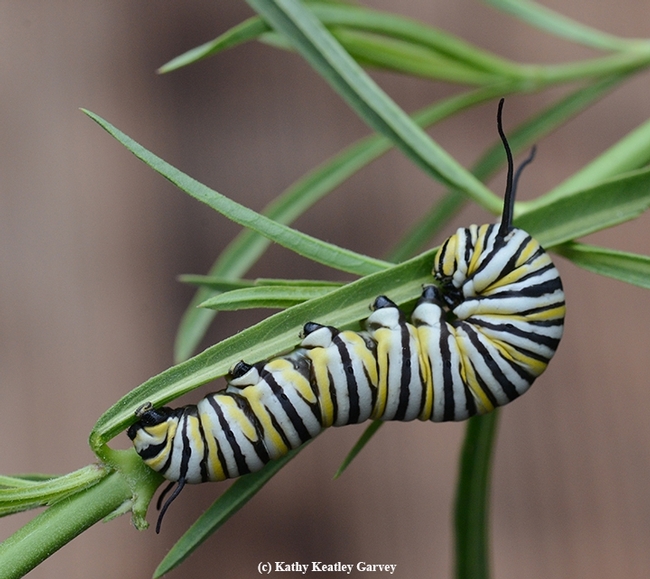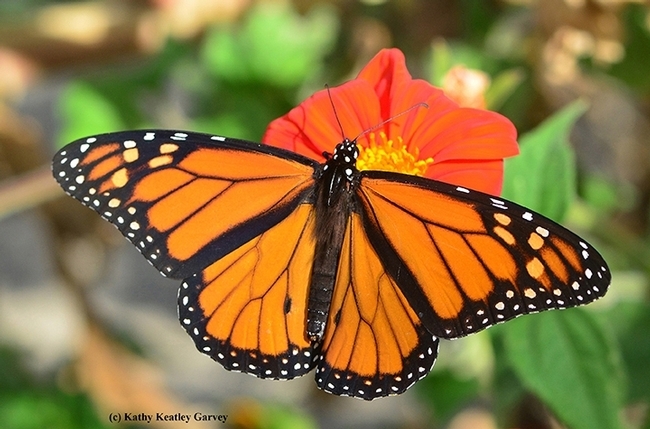
The feral cats on our farm (the progeny of strays dropped off by "imperfect" strangers) became known as "The Look-at-Cats." You couldn't touch, pet or hold them. You could feed them, though, and spay or neuter them--if you could catch them. And you could name them, too. "Look, there's a Look-at-Cat."
Now monarch caterpillars may be the new "Look-at-'Cats."
The troubling decline of monarchs, Danaus plexippus, has led the California Fish and Wildlife to post on its website and issue several mandates:
Conservation Status of Monarch Butterflies
"In 2014, monarchs were petitioned to be listed under the federal Endangered Species Act. In December 2020, the U.S. Fish and Wildlife Service found that listing was warranted but precluded (opens in new tab) by other listing actions on its National Priority List. The monarch is currently slated to be listed in 2024."
"In California, monarchs are included on the California Department of Fish and Wildlife's (CDFW) Terrestrial and Vernal Pool Invertebrates of Conservation Priority list (PDF) (opens in new tab) and identified as a Species of Greatest Conservation Need in California's State Wildlife Action Plan. California law (Fish and Game Section 1002) prohibits the take or possession of wildlife for scientific research, education, or propagation purposes without a valid Scientific Collection Permit (SCP) issued by CDFW. This applies to handling monarchs, removing them from the wild, or otherwise taking them for scientific or propagation purposes, including captive rearing. Due to the current status of the migratory monarch population, CDFW has also issued a mortarium on certain activities covered with an SCP. To learn more about obtaining a collection permit, see our SCP page."
What this means, according to biologist Hillary Sardiñas, senior environmental scientist and pollinator coordinator, Wildlife Diversity Program, California Department of Fish and Wildlife, is no handling or propagating them, including captive rearing, without a scientific collection permit (SCP).
As she wrote in an email today: "Monarch butterflies are a Terrestrial Invertebrate of Conservation Priority which means that handling or propagating them, including captive rearing, without a scientific collection permit (SCP) is not permitted, as described on our monarch website. We have gotten a number of questions on this topic and are currently developing an in-depth FAQ to help people understand threats to monarchs as well as what is and is not permitted. I am happy to share it with you once it is finalized. Unit then, here are answers to your questions:
- Are monarchs in a backyard considered wild? "Wildlife does not only occur on public lands, species can also inhabit private property, including backyards. Therefore, the permit requirement applies to handling activities wherever monarchs occur."
- Educational use? "A scientific collection permit (SCP) is also required for educational purposes. Therefore, the educator would need to have a valid SCP authorizing them to collect/receive and possess monarchs for this purpose. The person collecting the monarch on their behalf would also need a valid SCP or to be named on the educator's SCP. While monarchs have been an incredible tool to learn about long-distance migration and metamorphosis inspiring children and adults for generations, there are so few migratory monarchs that removing just 10 caterpillars could mean you are impacting 5% of the remaining population (estimated at <2,000 in the last overwintering census). At this time, we do not recommend moving caterpillars indoors for any purpose. If educators want to create a monarch garden so that students can observe adult butterflies lay eggs that develop into caterpillars, that scenario would provide an excellent educational opportunity while contributing to monarch conservation."
As Sardiñas, who holds a doctorate from UC Berkeley and formerly worked for the Xerces Society for Invertebrate Conservation, points out: "While monarchs used to be abundant, they are now scarce and the western migratory population has a high estimated likelihood of extinction. A shift from past actions that could cause harm to ones known to be beneficial, such as habitat creation, is required to promote their recovery."
You're encouraged to plant nectar sources and milkweed (the host plant) for the monarchs, but don't touch the eggs, caterpillars, chrysalids or adults. The 'cats, which many teachers traditionally collected to show their students metamorphosis and then released them into the wild--and which monarch moms and dads reared to protect from such predators as birds, wasps, spiders and praying mantids (and parasites)---are now "look-at-'cats."
Attached Images:
